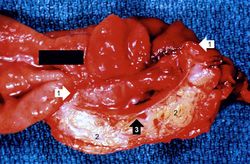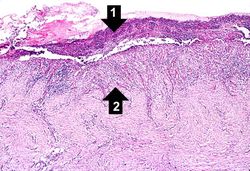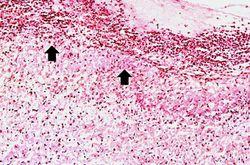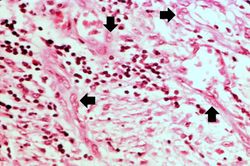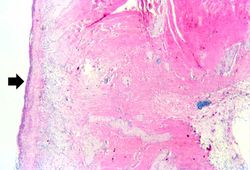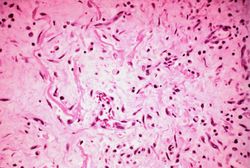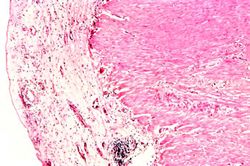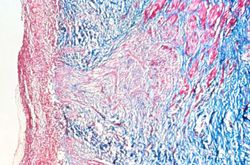Difference between revisions of "IPLab:Lab 3:Chronic Peptic Ulcer"
Seung Park (talk | contribs) |
(→Journal Articles) |
||
| (9 intermediate revisions by one other user not shown) | |||
| Line 16: | Line 16: | ||
File:IPLab3ChronicPepticUlcer11.jpg|This is a trichrome-stained section of tissue demonstrating fibrous connective tissue scar formation (blue color) in this lesion. The surface of the ulcer is at the left-hand side of the image. There is a layer of inflammatory cells and RBCs on the surface of the ulcer. | File:IPLab3ChronicPepticUlcer11.jpg|This is a trichrome-stained section of tissue demonstrating fibrous connective tissue scar formation (blue color) in this lesion. The surface of the ulcer is at the left-hand side of the image. There is a layer of inflammatory cells and RBCs on the surface of the ulcer. | ||
</gallery> | </gallery> | ||
| + | |||
| + | == Virtual Microscopy == | ||
| + | <peir-vm>IPLab3ChronicPepticUlcer</peir-vm> | ||
| + | |||
| + | == Study Questions == | ||
| + | * <spoiler text="What types of factors may predispose to peptic ulcer formation?">Alcoholic cirrhosis, chronic obstructive airway disease, chronic renal disease, and hyperparathyroidism or any condition which leads to hypercalcemia (calcium stimulates gastrin production).</spoiler> | ||
| + | * <spoiler text="Why is infection with Helicobacter pylori considered to be a significant risk factor for development of peptic ulcers?">''H. pylori'' is found in 90-100% of cases. It is thought that the ''H. pylori'' produce urease, leading to ammonia production and that they also produce a protease that breaks down glycoproteins in the mucus which forms the protective coat on the gastric mucosa.</spoiler> | ||
| + | * <spoiler text="What cells make of the inflammatory reaction at the base of this chronic ulcer?">The base of this chronic ulcer has a granulomatous inflammatory reaction composed of lymphocytes, macrophages, fibroblasts, and endothelial cells. This is in contrast to the acute inflammatory reaction at the surface of the ulcer due to irritation from the acid and gastric contents.</spoiler> | ||
| + | |||
| + | == Additional Resources == | ||
| + | === Reference === | ||
| + | * [http://emedicine.medscape.com/article/181753-overview eMedicine Medical Library: Peptic Ulcer Disease] | ||
| + | * [http://www.merckmanuals.com/professional/gastrointestinal_disorders/gastritis_and_peptic_ulcer_disease/gastritis.html Merck Manual: Gastritis and Peptic Ulcer Disease] | ||
| + | |||
| + | === Journal Articles === | ||
| + | * Laine L. [http://www.nejm.org/doi/10.1056/NEJMcp1514257 Upper Gastrointestinal Bleeding Due to a Peptic Ulcer.] ''NEJM'' 2016 June 22; 374: 2367-2376. | ||
| + | |||
| + | === Images === | ||
| + | * [{{SERVER}}/library/index.php?/tags/122-peptic_ulcer PEIR Digital Library: Peptic Ulcer Images] | ||
| + | * [http://library.med.utah.edu/WebPath/GIHTML/GIIDX.html#2 WebPath: Stomach Pathology] | ||
{{IPLab 3}} | {{IPLab 3}} | ||
[[Category: IPLab:Lab 3]] | [[Category: IPLab:Lab 3]] | ||
Latest revision as of 14:09, 25 August 2016
Contents
Clinical Summary[edit]
This 56-year-old white female was admitted to the hospital with a six-year history of epigastric pain and burning. This pain was said to be worse at night and on an empty stomach. The patient reported that the pain was relieved by drinking milk. She had also experienced several episodes of hematemesis and melena since the onset of the pain, the last episode occurring 3 weeks prior to admission. The patient described intermittent episodes of colicky pain in the right upper quadrant and right side of the abdomen, frequently radiating to the back and shoulders and often accompanied by "bilious vomiting." Physical examination was noncontributory except for tenderness in the epigastrium and right upper quadrant. An upper GI series showed changes suggestive of a neoplasm. The patient submitted to an abdominal exploration at which time a partial gastrectomy was performed.
Images[edit]
This low-power photomicrograph demonstrates the healing reaction in the base of this ulcer. The base of the ulcer is at the left-hand side of the image and the serosal surface is at the right. Note the fibrous connective tissue within the wall of the stomach and the layer of inflammatory exudate on the surface of the ulcer (arrow).
Virtual Microscopy[edit]
Study Questions[edit]
Additional Resources[edit]
Reference[edit]
Journal Articles[edit]
- Laine L. Upper Gastrointestinal Bleeding Due to a Peptic Ulcer. NEJM 2016 June 22; 374: 2367-2376.
Images[edit]
Hematemesis is the vomiting of blood.
Melena is the passage of digested blood in the feces.
Colicky pain is an intermittent abdominal pain.
Bilious vomitus is vomitus which contains bile.
An upper GI series is a series of barium-aided radiographs involving the esophagus, stomach, and duodenum.
Cirrhosis is a liver disease characterized by necrosis, fibrosis, loss of normal liver architecture, and hyperplastic nodules.
Hypercalcemia is the state of having increased levels of calcium in the blood.
The normal fibrinogen level is 184 to 412 mg/dL.

